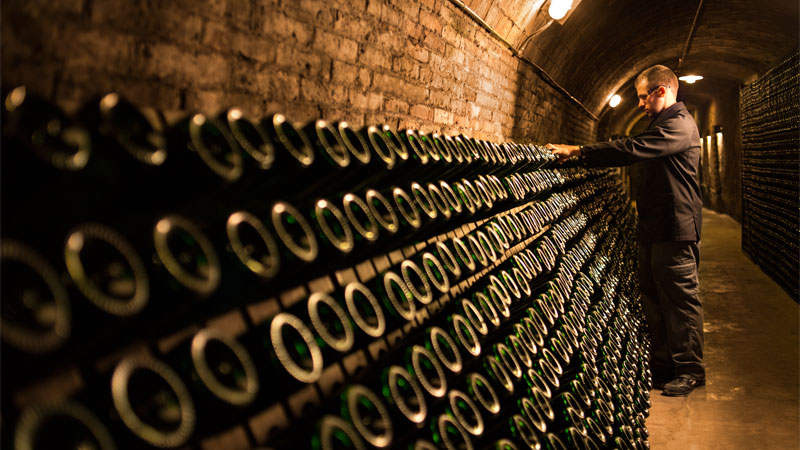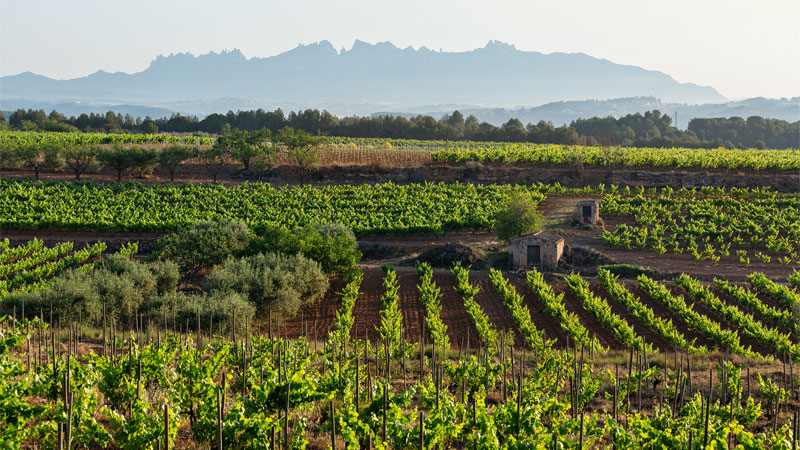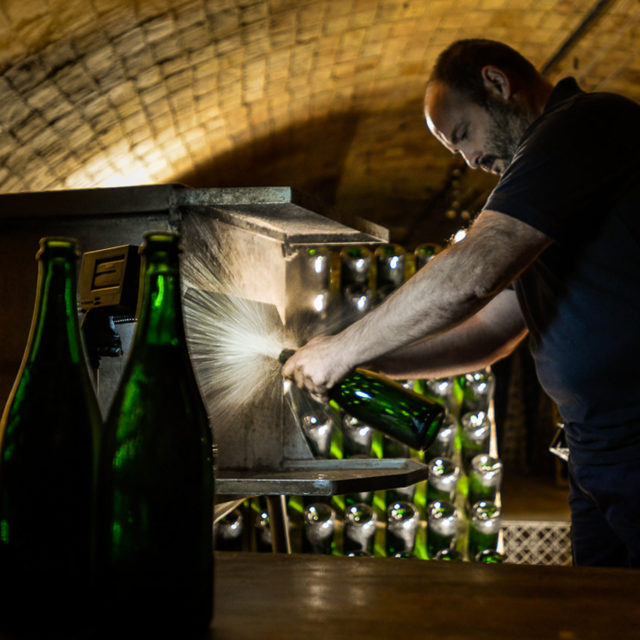In February 2019, a simmering dispute within the Cava denomination of origin (Cava D.O.) rose to a boil when, after months of negotiations, nine of its most prestigious producers abandoned the designation. Dissatisfied with the D.O.’s failure to address the dichotomy in winemaking practices between large- and small-scale producers, these nine brands opted to label their wines instead using a new, quality-focused term, Corpinnat.
Corpinnat is an E.U.-recognized sparkling wine association. Used on bottle labels, the name indicates specific regional qualifications. Fusing Latin and Catalan words, the Corpinnat name means “from the heart of the Penedès.” The group currently comprises nine sparkling wine makers from the Penedès region: Gramona, Recaredo, Torelló, Llopart, Nadal, Sabaté i Coca, Mas Candí, Huget-Can Feixes, and Júlia Vernet.
For most wine drinkers, distinguishing Corpinnat as a separate entity means little more than a scarcely noticeable label modification (the producers replaced the word “Cava” with “Corpinnat”). For the D.O., however, it amounts to much more, highlighting a vast ideological divide between the D.O.’s large- and small-scale producers.
Don't Miss A Drop
Get the latest in beer, wine, and cocktail culture sent straight to your inbox.Currently, every Cava producer falls under the same designation, despite huge differences in farming and winemaking practices. The 2019 departure wasn’t the first time smaller producers attempted to stress this fact, but it represented the highest-profile example to date of the D.O.’s failure to address the differences between the industrial farming techniques favored by large-scale Cava producers, which focus on high-volume production; and the hand-harvested, organically farmed practices of smaller vineyards, which aim for high quality.
Assessing the effect of this separation on the Cava category, or the success of Corpinnat as an independent entity, is a premature endeavor, since the splinter is still fresh. But this group of small, passionate producers is working to prove that this distinction is necessary, and that there is great Spanish sparkling wine beyond Cava.

Since its formation in 1972, the Cava D.O. has become one of the most recognizable names in sparkling wine production. In 2017, output reached a record peak of 252 million bottles. Of that total, an estimated 80 percent came from three producers: Freixenet, Codorníu, and García Carrión, also known as “the big three.”
The dominance of such a small set of wineries has resulted in something of a price war between these producers, cementing Cava’s status as a budget wine. Between them, the “big three” brands’ flagship wines carry an average price of under $10 per bottle, whereas recommendable bottles start at at least $15.
Another peculiarity of the Cava D.O. that further dampens its credentials: Provided they’re made in accordance with to the D.O.’s (relatively loose) specifications, wines from a range of different municipalities throughout Spain can be classified as Cava. This seems to ignore the concept of terroir, as the regions range from Penedès, the traditional Cava heartland in Catalonia, to País Vasco (the Basque Country), 325 miles northwest. These regions experience deeply varied climates, and contain vastly different soil compositions, parameters that a D.O., by definition, is meant to precisely limit.
In 2017, as a response to these shortcomings, the Cava Regulatory Board created a new category for single-estate sparkling wines, Cava Paraje Calificado (CPC). This category focused on vineyard designations, and imposed lower yields and longer aging periods. But the CPC category permitted both large and small producers to enter the category, and only affected the wines producers wished to qualify as CPC, while ignoring the rest of their production.
Before the CPC category was established, a small group of quality-driven Cava producers began working on a separate, even stricter set of guidelines that would act as a rigid framework for producing the highest quality Cava. Formed in 2015, ratified by the E.U. at the end of 2017, and officially announced in April 2018, they established the Association of Wine Producers and Growers Corpinnat (Corpinnat).
“We want to show the world that great sparkling wines can be made in our territory,” Xavier Gramona, owner of the Gramona winery and co-president of the association, said in a recent interview. Rather than separate from Cava, the Corpinnat members initially wanted to convey this message as part of the D.O., Gramona tells VinePair. “We told the regulatory board that there was a need to clearly explain on labels why some Cavas retail at $5 and others at $100.”
In similar fashion to the tiered appellation systems of France, or Germany’s Grosses Gewächs classification, the group wanted to include the Corpinnat term alongside the Cava D.O. on all bottle labels from wineries that met its membership requirements.
Published in 2018, these requirements include 100 percent organic farming and fully hand-harvested vineyards. Wineries are required to grow their grapes within a 57,000-acre expanse in the Penedès region, and blends must contain at least 90 percent “historic” varietals (the association defines these as Xarel·lo, Macabeu, Parellada, and Malvasia for whites, and Garnacha, Monastrell, Sumoll, and Xarel·lo Vermell for reds).
Grapes can be sourced from independent growers, though these farmers must be paid a minimum rate that is significantly higher than the Cava D.O. requires. The wines must then be entirely vinified on the winery’s premises, however, and following vinification, the wines must age for at least 18 months before release.
In essence, these regulations ruled out the “big three” producers from ever applying as, among other things, they rely heavily on non-organic vineyards and buy in large volumes of base wines.
In 2018, when the Corpinnat association met with the D.O. to begin the process of incorporating the term on Cava labels, the D.O. told the group that their ideals were incompatible. (This may have been linked to the strong lobbying presence of the “big three” within the regulatory board.) To add further insult, Gramona says the D.O. gave the group an ultimatum: Go to the European Union, withdraw your association, and cease all promotion of Corpinnat, or abandon the Cava D.O.

Of course, not everyone in the industry is approaching the new category with the Corpinnat association’s gusto.
“As a retailer, it’s not necessarily an explanation or conversation I want to get into with every customer who’s looking for a ‘Cava,’” Andy Booth, co-owner of The Spanish Table, a California mini-chain of food, wine, and cookware stores, says. “Honestly, I don’t see that it’s going to make much of a difference,” he adds.
Whether they’re spending $10 or $200, Booth’s customers typically enter his stores with a set budget in mind and don’t tend to prioritize specific denominations or categories, he says. Booth recommends bottles based on food pairings and customer’s preferences, and avoids taking a deep dive into the nuances of Spanish denominations, unless that’s something guests want to explore.
“I think the biggest thing working in favor of [Corpinnat] producers is the storytelling aspect,” Patrick Mata, founding partner at Olé and Obrigado Imports, says. “It’s a more organized, clearer way of communicating the quality of their product.”
If anything, Mata feels it may now be even easier for Corpinnat producers to sell their wines as they don’t contain the word Cava. “For many years and for many people, Cava was Cordon Negro from Freixenet,” he says. (Freixenet’s black and gold Cordon Negro bottles are ubiquitous in American liquor stores and retail for around $10.)
Félix Meana, co-owner and director of operations at Asheville’s critically acclaimed Spanish restaurant Cúrate, believes that the fact Corpinnat represents a specific terroir, compared to multiple regions around the country, is a huge bonus for consumers. It’s an idea he’s already started introducing to guests.
“When you think about Cava, you instantly think about affordable [wine] and a cheaper version of Champagne,” Meana says. “[But] we have beautiful, beautiful, sparkling wine coming from Catalonia. I think having separate categories helps educate our clients on that.”
